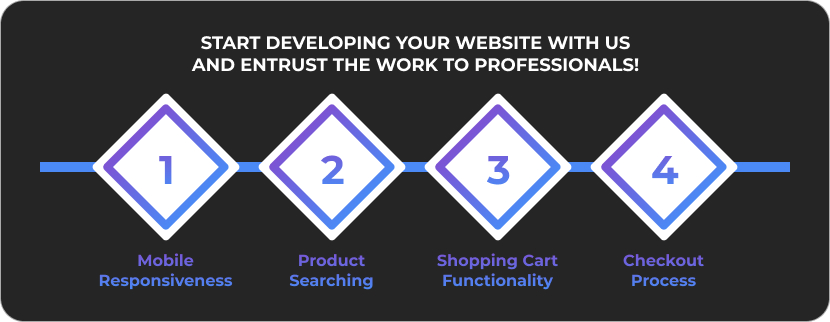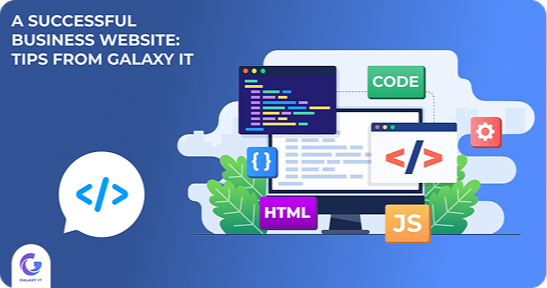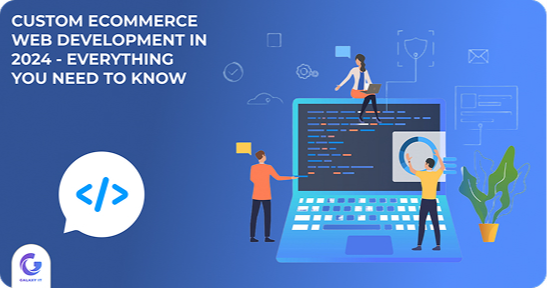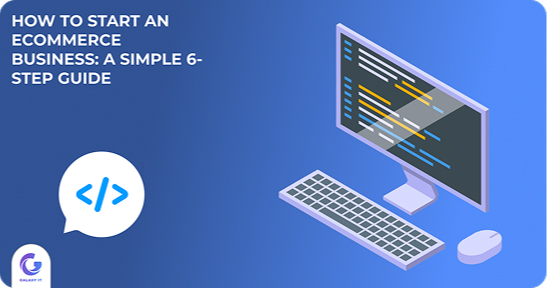Ecommerce Website Development: The Ultimate Guide
- 15.04.2024
- 37 views
- 10 min
Popular Options for Ecommerce Website Development
Developing an ecommerce website doesn't need to be a daunting task. Our guide simplifies the process into seven distinct steps, providing practical insights along the way to facilitate the creation and launch of your website.
Before delving into the details, it's essential to understand the primary options available for developing your ecommerce website.
Consider Hiring a Developer for Custom Ecommerce Site Coding
Creating a custom ecommerce website involves utilizing various programming languages to craft a unique site tailored to your specific requirements. While this approach allows for precise customization, it typically requires extensive development expertise or collaboration with a skilled freelancer or agency.
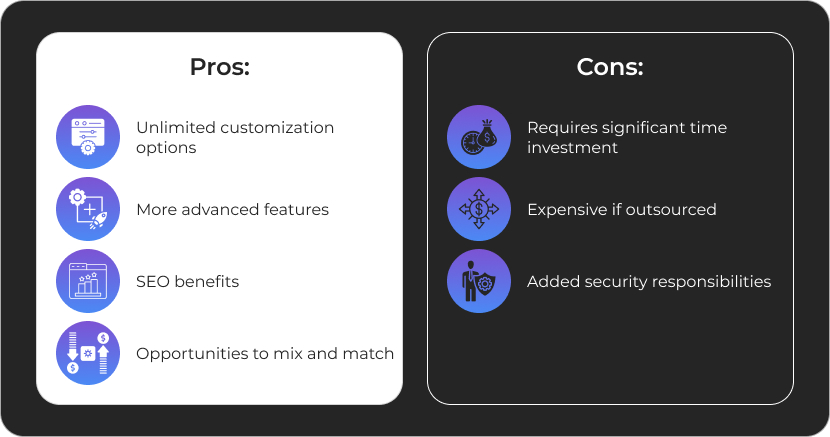
If you're considering this option, Galaxy IT inc can assist you in finding a reputable agency specializing in web development.
Pros:
- Unlimited customization options: Custom coding allows you to tailor every aspect of your website to suit your business's unique needs.
- More advanced features: With custom coding, you can incorporate complex features that may not be available with standard website builder tools.
- SEO benefits: Optimizing nearly every relevant element enables you to enhance search engine visibility and improve the site's relevance to search terms.
- Opportunities to mix and match: You have the flexibility to select your hosting provider, integrate specific technologies, and design a custom architecture aligned with your business requirements.
Cons:
- Requires significant time investment: Custom coding demands more time than using pre-configured options offered by website builders. Additionally, ongoing maintenance necessitates a considerable time commitment.
- Expensive if outsourced: Outsourcing custom coding entails expenses for hiring a web development agency, hosting, domain registration, and other related costs.
- Added security responsibilities: Apart from ensuring the website's functionality and appearance, you are responsible for safeguarding sensitive customer data and addressing any potential vulnerabilities.
Which Ecommerce Website Development Approach Should You Use?
Choosing the right approach for developing an ecommerce website depends on your unique business needs. There isn't a universally "correct" method, but rather the one that aligns best with your company's requirements.
To make an informed decision on how to proceed with ecommerce website development, consider asking yourself the following questions:
- Financial Considerations: Can you afford the upfront investment required for a custom-coded website, or would paying monthly fees to a website builder platform be more financially viable?
- Customization Needs: What specific customizations does your website require? Can these be accommodated by a Software-as-a-Service (SaaS) builder platform?
- Timeline for Launch: How urgently do you need to launch your ecommerce website? Are you willing to wait for a longer launch period associated with a custom build, or do you prefer a quicker setup achievable through a website builder?
- Expertise and Maintenance: Do you possess the internal expertise and resources necessary to handle the ongoing coding and security maintenance inherent in a custom-coded solution?
- Scalability: Will your chosen approach allow your website to scale alongside your business without encountering significant performance or financial challenges?
By considering these factors, you can determine the most suitable approach for developing your ecommerce website that best meets your company's needs and goals.
How to Build an Ecommerce Website
Regardless of the development approach you choose, certain steps are fundamental to building an ecommerce website.
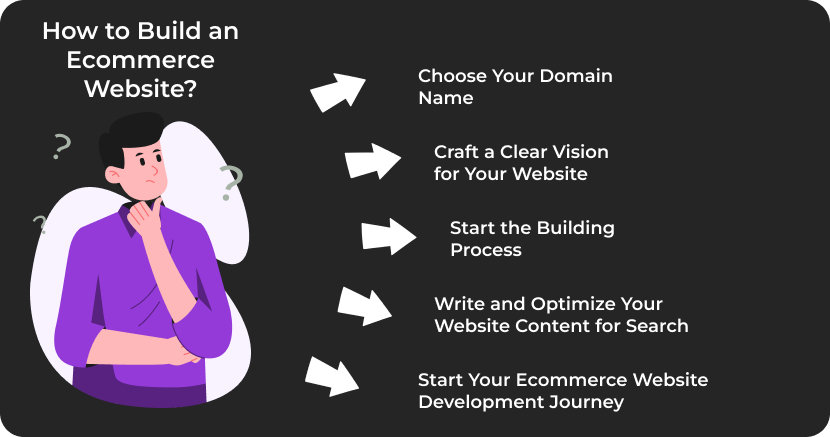
Choose Your Domain Name:
Your domain name (e.g., galaxy-it.net) serves as your ecommerce website's digital address and plays a crucial role in your online identity. Here are some tips for selecting the right one:
- Keep it short and memorable: Opt for a concise and catchy domain name that's easy for your customers to recall. For instance, "galaxy-it.net" is more memorable than "bestartsuppliesandcraftmaterialsonline.com."
- Maintain brand consistency: Ensure your domain name aligns with your company name to reinforce brand recognition.
- Avoid hyphens and numbers: Steer clear of hyphens and numerical characters in your domain name, as they can cause confusion, especially when spoken aloud.
- Consider country-specific domains: If applicable, explore country-specific domain options that may resonate better with local customers.
Brainstorm multiple domain name options and then verify their availability using a domain name registrar like GoDaddy or BlueHost. Many ecommerce website builders also offer tools to check domain name availability and facilitate purchasing directly within their platforms.
Craft a Clear Vision for Your Website
The frontend of your ecommerce website serves as the face of your brand, conveying your identity and core values to users. Establishing consistent branding not only reinforces your identity but also fosters trust among visitors, which is crucial as trust significantly impacts purchasing decisions, as evidenced by research from Edelman.
To effectively engage prospective customers, it's essential to approach your website development with a clear vision of how you want it to look and feel. This vision can be categorized into four key aspects:
Design:
A visually appealing website leaves a lasting impression on visitors and encourages further exploration of your products or services. For instance, MVMT, an accessory brand, epitomizes their motto "style shouldn't break the bank" through a sleek and minimalist website design.
When designing your website, take into account various elements such as imagery, white space, fonts, colors, videos, and more. These components collectively contribute to creating a visually appealing and engaging user experience.
Additionally, integrating a dedicated section to showcase customer reviews can significantly enhance your credibility and influence purchasing decisions positively. For instance, Tushbaby, a baby carrier brand, effectively boosts its credibility by prominently displaying its average customer rating, total number of reviews, and review excerpts on its homepage.
When evaluating your design preferences, consider asking the following questions:
- Minimalist vs. Elaborate Design: Do you lean towards a minimalist approach characterized by clean lines and generous white space, or do you envision a more elaborate design featuring bold colors and dynamic visuals?
- Audience Preferences: What are the preferences of your target audience? Understanding their preferences and behaviors can guide design decisions to better resonate with them.
- Reflecting Brand Identity and Values: Which elements will effectively reflect your brand's identity and core values? Incorporating design elements that align with your brand identity helps to establish authenticity and build trust with your audience.
- Accessibility: How can you ensure that your website is accessible to all users, including those with disabilities? Consider implementing features such as alternative text for images, keyboard navigation, and high contrast options to enhance accessibility and inclusivity.
Structure:
A well-organized site structure is essential for both search engine optimization and user experience. By logically grouping similar content, you ensure that both search engines and users can navigate your site efficiently, while also giving important pages the visibility they deserve.
Here's an example of what a well-organized site structure might look like:
Indeed, planning your main categories and determining the types of subcategories and pages under each is crucial for creating a coherent site structure. This process allows you to map out the hierarchy of your website and ensures that content is organized in a logical and intuitive manner.
Once you have defined your main categories, you can further break them down into subcategories and individual pages as needed. This granular approach enables visitors to navigate your site seamlessly, finding the information they need efficiently.
Start the Building Process
Having a clear vision of how you want your website to look, function, and be structured serves as a roadmap for setting up your online presence effectively. If you've chosen a custom-built website, it's essential to communicate your requirements clearly to the developer(s). Provide them with detailed guidance in the form of wireframes, creative assets, and written specifications. This ensures that the final product aligns with your vision and meets your expectations.
When selecting a theme or discussing requirements with your developer(s), it's essential to consider the following factors: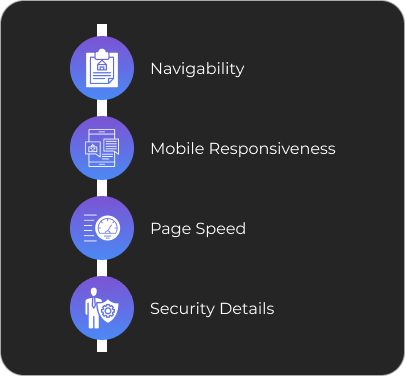
- Navigability: Ensure that key features such as category menus, search bars, and shopping carts are easily accessible and prominently displayed. A well-organized navigation structure enhances user experience and facilitates seamless browsing.
- Mobile Responsiveness: Opt for a responsive design that adapts to various screen sizes, ensuring your website functions optimally for users accessing it on mobile devices. Many themes come with built-in responsiveness, but it's crucial to verify this feature to cater to mobile users effectively.
- Page Speed: Prioritize page speed by minimizing the size of large image and animation files. Slow loading times can deter potential customers and negatively impact user experience. Optimizing your website for faster load times enhances usability and encourages visitor engagement.
- Security Details: If opting for a custom-coded website, emphasize the importance of implementing robust security measures to protect sensitive customer data. Alternatively, if using a pre-built theme, ensure that it receives regular updates for performance improvements and security patches. This helps safeguard your website against potential vulnerabilities and ensures a secure browsing experience for visitors.
Write and Optimize Your Website Content for Search
Once the framework of your website is established, it's time to focus on creating written content. Start by developing the following foundational pages:
- Homepage: Capture visitors' attention by showcasing your core products and highlighting unique aspects of your business.
- Product Pages: Persuade potential customers to make a purchase through compelling product descriptions and high-quality images.
- About Page: Share your brand's story to foster a connection with your target audience and build trust.
- FAQ Page: Address common customer inquiries in one centralized location, saving visitors time and providing valuable information.
- Privacy Policy Page: Clearly outline how your brand collects, uses, and protects customer data to establish transparency and trustworthiness.
- Contact Page: Make it effortless for customers to reach out to your customer service team by providing contact information and a contact form.
- Blog Posts: Offer informative content that attracts new prospects and introduces them to your brand. Blogging not only provides value to your audience but also helps improve your website's search engine ranking.
When creating content, keep search engine optimization (SEO) principles in mind to enhance your website's visibility on search engine results pages (SERPs) and drive more organic traffic. By incorporating relevant keywords, optimizing meta tags, and producing high-quality, relevant content, you can improve your website's chances of ranking higher in search results.
Add Payment Methods
Ecommerce website builders typically offer integrated payment solutions that simplify the process of setting up and accepting payments from customers. For instance, Shopify provides a built-in payment gateway that enables you to accept payments via credit cards and other popular options such as PayPal. This seamless integration streamlines the checkout process for customers and facilitates secure transactions, enhancing the overall shopping experience.
While ecommerce builders' payment functions offer convenience, they may not support every relevant payment type.
With a custom-coded website, you have greater flexibility and control. You can integrate any payment provider of your choice using API integrations or third-party plugins, accommodating a wider range of payment methods to cater to diverse customer preferences. This level of customization ensures that your ecommerce platform is aligned with your specific business needs and provides a seamless payment experience for your customers.
Set up Shipping and Delivery Functions

Setting up shipping and delivery functions is crucial for ensuring a smooth customer experience on your ecommerce website. Here are some steps to consider:
- Determine Shipping Details: Decide on shipping fee types (e.g., free, flat rate) and how orders will be fulfilled (e.g., self-packing, third-party logistics). Consider factors like shipping carriers, delivery times, and packaging requirements.
- Clarify Shipping Information: Clearly define shipping zones within your ecommerce platform based on geographic locations. This helps streamline the shipping process and ensures accurate calculations at checkout.
- Enable Order Tracking: Implement order tracking functionality to allow customers to easily monitor the status of their orders. This helps enhance transparency and customer satisfaction.
- Integrate Shipping Calculator: Incorporate a shipping calculator tool that provides real-time shipping cost estimates based on factors like destination, package weight, and shipping method. This helps customers make informed decisions during checkout.
- Communicate Shipping Policy: Include a clear shipping and delivery policy on your website, outlining details such as shipping rates, delivery times, return policies, and any applicable terms and conditions. Transparency in shipping policies builds trust and helps manage customer expectations.
By addressing these aspects of shipping and delivery, you can streamline the order fulfillment process, provide transparency to customers, and enhance their overall shopping experience on your ecommerce website.
Test and Publish Your Website
Before launching your website, thorough testing is essential to ensure it looks and functions as intended, preventing potential issues post-launch. Put yourself in the shoes of your customers and examine areas that could impact their experience negatively:
Once you are satisfied with the testing results, it's time to launch your website. However, continue to allocate time to monitor your site's performance and address any issues that may arise post-launch. Regular maintenance and optimization are essential for ensuring the long-term success and effectiveness of your ecommerce website.
Start Your Ecommerce Website Development Journey
Before embarking on the journey of creating an ecommerce website, it's crucial to consider various factors. However, meticulous planning in the initial stages sets the stage for a seamless launch later on.
Investing in the right tools throughout the process can streamline each step and contribute to the success of your ecommerce venture.
Galaxy IT provides top-notch solutions for developing ecommerce projects and specializes in launching products from scratch. Start developing your website with us and entrust the work to professionals.
- Mobile Responsiveness: Test your website across various devices and screen sizes to ensure it displays correctly and functions seamlessly on mobile devices.
- Product Searching and Filtering: Verify that the product search functionality works efficiently and that filtering options help users find products quickly and easily.
- Shopping Cart Functionality: Test the process of adding and removing products from the shopping cart to ensure it is intuitive and error-free.
- Checkout Process: Carefully review the checkout process to identify any potential obstacles or friction points that could deter customers from completing their purchase. Ensure that the process is straightforward, secure, and optimized for conversions.
